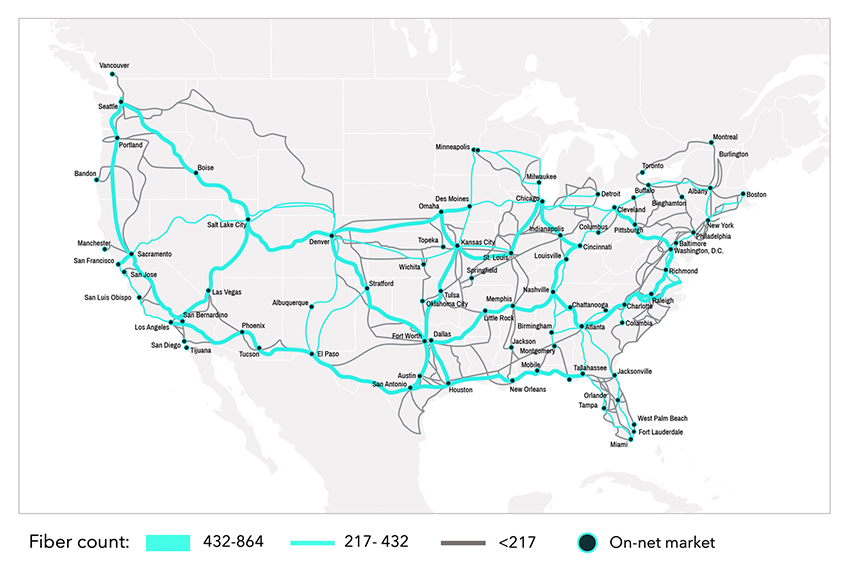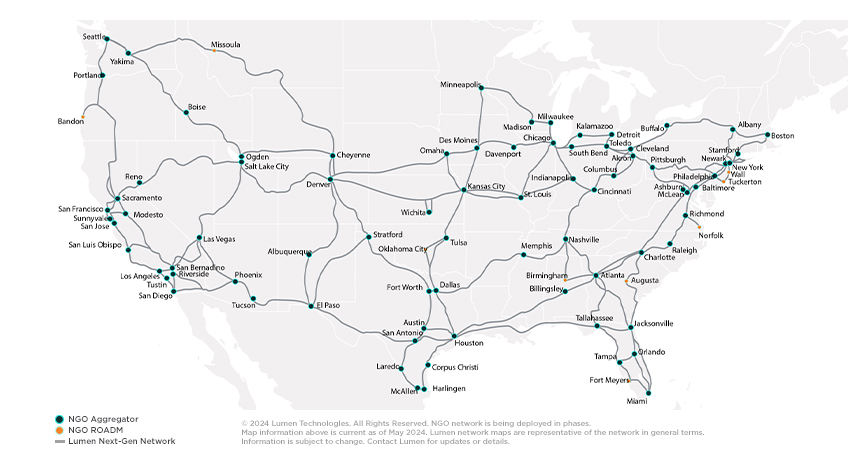
Over the past last several months, we’ve been meeting with leading growth companies ranging from hyperscalers to financial services firms to discuss the connectivity they need to support an AI-driven future. It’s clear from our conversations that the next wave of AI advancements is changing the way many businesses think about their networks.
Many of them are looking for greater connectivity, data access, processing power and transmission between data centers and across enterprise networks. When it comes to connectivity, they find themselves at a critical fork in the road: Should they build a next-generation network themselves—or try to find the perfect partner to understand their needs?
In this post, we explore the network requirements companies need to manage today’s unprecedented data flows and demonstrate why Lumen is designed to be the number one provider of AI-ready infrastructure.
Transforming Networks for AI
All the companies we spoke to had similar needs, but five areas emerged as the most critical for the AI era. Here’s how Lumen is uniquely qualified to meet each of these requirements, enabling companies to innovate with AI and move to the forefront of their industries.
- Increased data traffic
It’s no secret that AI applications generate massive amounts of data that require processing, especially when training models—which means transferring large datasets across networks. AI-driven applications such as virtual assistants interact with users in real time, continuously sending and receiving data to provide personalized experiences.
There’s a lot of discussion about the race for compute capacity and massive investments in data centers and chip production, but there have been fewer discussions about how all that data will be transmitted. According to current projections, data usage is expected to increase exponentially over the next five years, with forecasts suggesting a mind-boggling 660 zettabytes of data globally by 2030.1 To put that into perspective, a single zettabyte is equal to approximately 1,000 exabytes or 1 billion terabytes—meaning that it would take a billion one-terabyte hard drives to store just one zettabyte of data. Compounding the challenge is the fact that much of this will be data in motion—so network capacity will be equally as important as compute capacity.
The most ambitious AI innovators will face the additional challenge of accessing a network that ensures all the data generated by AI models reaches the right destination at the right time.
AI applications have an urgent need for data delivery capacity to support multimodal AI capabilities such as text, images and video. Lumen anticipated this level of demand years ago as it began building out its fiber network by adding multiple conduits that can be easily filled with the latest fiber technology as demand increases.
We built the world’s largest ultra-low loss intercity fiber network in North America with diverse routes to more than 50 major cities across the country and millions of miles of dark fiber in dense urban areas where it is now needed. This allows us to outperform many older fiber installations that were designed when data demand was a fraction of what it is now. These now face a challenging upgrade to meet AI demand in densely populated areas.

Figure 1. Fiber count on Lumen Network routes across the U.S.
The average Lumen conduit fiber count is above 500, giving our network 60% more capacity than legacy fiber networks. This urban capacity, combined with our advanced optical networking, enables our customers to add multiple 400 Gbps waves, soon to reach 800 Gbps and 1.6 Tbps.
We’ve also been ranked the #1 provider of Wavelengths Services by Vertical Systems Group three consecutive times. To qualify, providers must claim at least four percent (4%) of the U.S. market for retail and wholesale wavelength services.

Figure 2. The Lumen next-generation optical network provides high-speed fiber connections between dozens of major U.S. metro areas.
2. Network latency
AI platforms require real-time data processing and response. Many AI platform providers are focused on optimizing hardware and software to maximize compute performance, but latency is most often rooted in a WAN delay. With AI models, the customer experience is as critical to get right as the algorithms within them. These tools are meant to be companions to the human experience—and humans work in real time. That’s why reducing WAN delay is crucial for improving AI performance.
Our distributed edge fabric of high-capacity compute and storage resources is designed to deliver near-zero latency to meet 97% of U.S. business demand, uniquely positioning Lumen to support AI workloads with flexible access for real-time data processing.
3. Security and privacy concerns
AI systems require large datasets for training, and how that data is collected, stored and used raises significant privacy concerns. This sensitive data must be protected with robust security measures anywhere the data is transported.
Lumen operates one of the world’s largest, most interconnected networks, providing end-to-end visibility into most data traveling along it. More than 50% of the traffic that starts on our network stays on it, avoiding the vulnerability often found at transition points between networks. Our elite team of in-house threat intelligence experts at Black Lotus Labs® constantly monitors and proactively defends this traffic using AI intelligence and unmatched threat visibility.
4. Fluctuating demand
Like many applications, AI platform demand can fluctuate quickly driven by seasonal variations, market trends, global events and regulatory changes. Your connectivity fabric must be able to scale dynamically to handle varying demands.
The Lumen Network allows customers to spin up a new connection in as little as five minutes—thanks to our fully digital Network-as-a-Service capabilities. Also, our ability to control layers 1-3 (waves, ethernet and IP) of our network architecture is increasingly critical to AI platforms, driving improved performance, security, scalability, reliability and cost efficiency.
5. Speed to market
When deciding whether to build or lease a network, it’s not the total cost driving the decision; it’s the total time to market. When you consider all that goes into building a custom fiber network—including physically building connections between new and existing data centers and the internet backbone most organizations rely on—a lot of expected and unexpected challenges can slow things down. These include permit and regulatory challenges, supply chain hiccups and the technical integration between newer and older infrastructure, which can extend timelines.
The vast Lumen fiber network can help get AI innovation to market fast—empowering your business to gain a competitive edge. To give you a sense of our network scale, we have more than 6 million U.S. intercity fiber miles (and another 5.8 million in progress) and secure, ultra-low latency connections to over 2,200+ public and private data centers worldwide. Plus, with more than 30 years of experience integrating networks, we have the expertise to support your connectivity needs, no matter how large.
By providing robust network solutions that ensure efficient data transfer, low latency, strong security measures, scalability and rapid deployment, Lumen is positioned to become the network of choice for organizations that want to stay ahead in the AI innovation race.
Evaluate Your Build Vs. Lease Options With Lumen
The leaders who have chosen to partner with Lumen over building their own private connectivity are doing so because they see the advantages of the scale that the Lumen Network provides, the expertise of our managed fiber and waves services, and the potential of our digital services to access that network with on-demand capabilities. By partnering with Lumen, they feel confident that they can meet their most critical long-term needs in an AI-driven future.
If you know someone standing at the fork in the road of building vs. buying an AI-ready infrastructure, please share this post with them.
If you’re not running an AI platform but manage an AI initiative at your organization, check out Lumen Digital to help solve for these challenges at your scale.
And for more insights on the private, flexible fabric that customers are choosing to power their AI initiatives, explore Private Connectivity Fabric.
LEARN MORE
1TechTarget, “How do big data and AI work together?,” August 22, 2023.
This content is provided for informational purposes only and may require additional research and substantiation by the end user. In addition, the information is provided “as is” without any warranty or condition of any kind, either express or implied. Use of this information is at the end user’s own risk. Lumen does not warrant that the information will meet the end user’s requirements or that the implementation or usage of this information will result in the desired outcome of the end user. All third-party company and product or service names referenced in this article are for identification purposes only and do not imply endorsement or affiliation with Lumen. This document represents Lumen products and offerings as of the date of issue. Services not available everywhere. Lumen may change or cancel products and services or substitute similar products and services at its sole discretion without notice. ©2024 Lumen Technologies. All Rights Reserved.
The post Top 5 Reasons AI Leaders are Turning to Private Connectivity Fabric first appeared on Lumen.
The post Top 5 Reasons AI Leaders are Turning to Private Connectivity Fabric appeared first on Lumen.
Article Link: Top 5 Reasons AI Leaders are Turning to Private Connectivity Fabric - Lumen